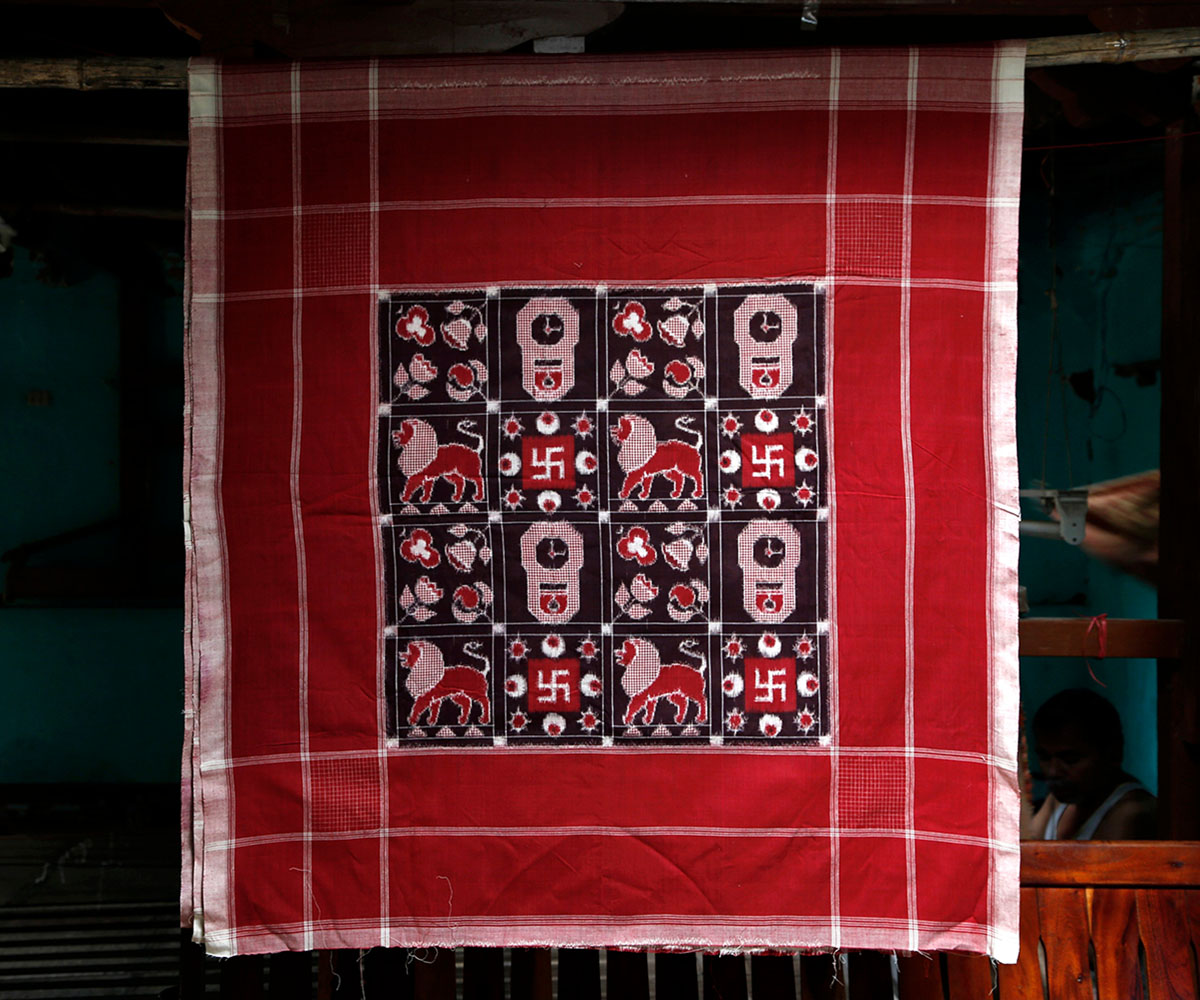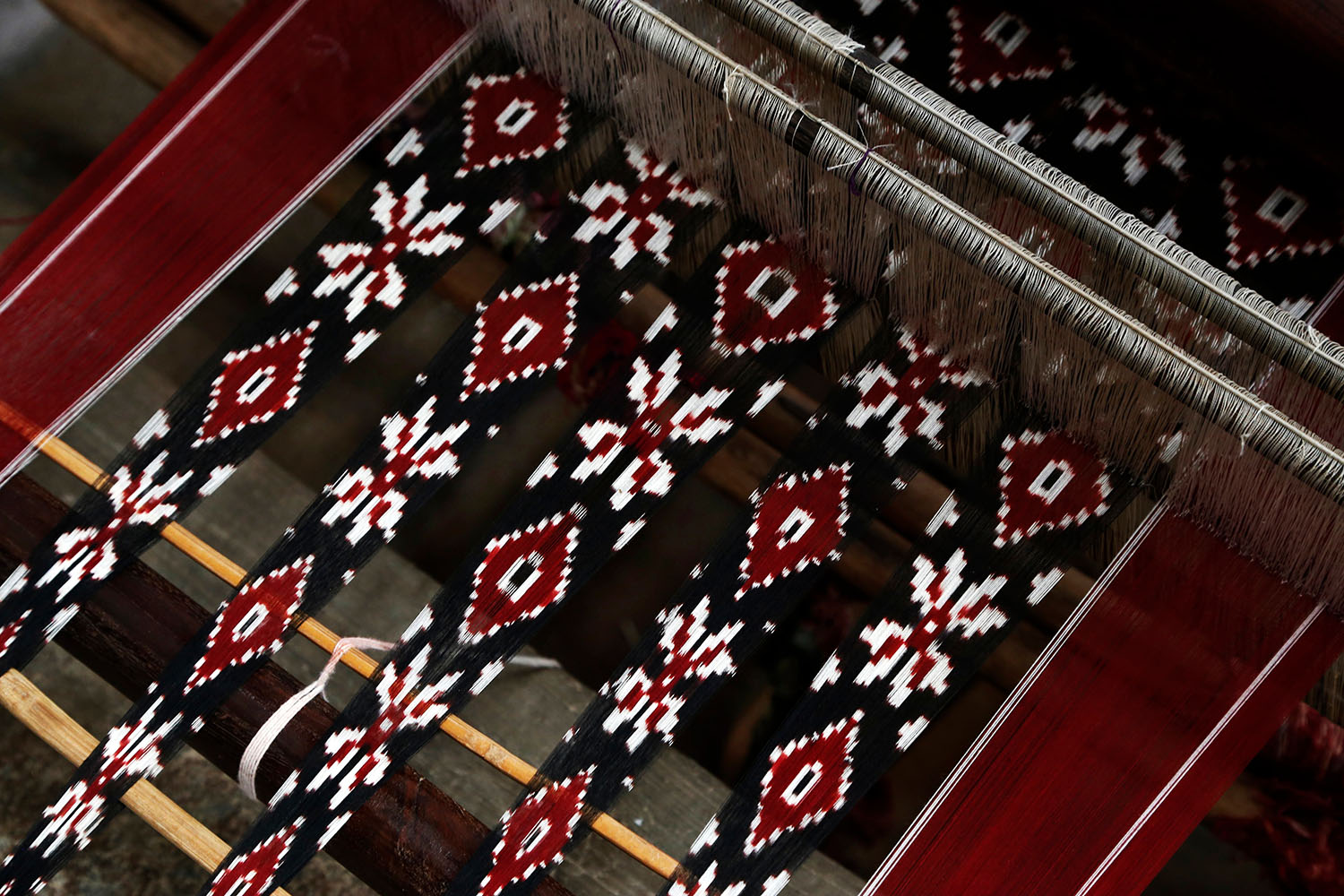ARTICLE
Double Ikat
An intricate and meticulous technique of tie-resist-dyeing, double ikat is currently practised in only three countries in the world: India, Indonesia and Japan. In it, the warp and weft are resist-tied according to a specific design and, when woven, intermesh seamlessly to reveal this pattern. For this reason, the process of preparing the warp and weft yarns for dyeing demands the same degree of mathematical precision as the process of weaving the textile on the loom.
The process of double ikat begins with the plotting of the design on a graph, which is then carried over on to the warp and weft yarns. The preparation of the warp and weft yarns is a crucial step in the double ikat process. A single double ikat textile has a pattern with repeating motifs and it is common for weavers to create multiple textiles with the same pattern. For example, in patola weaving, the warp prepared suffices for three patola saris of the same pattern and for telia rumals, as well, multiple pieces with the same motif arrangements are woven. The yarn is folded in such a manner that the plotting of the design on the yarn and the tying can be done at one time for all the pieces. This is an economical choice as the tying of the yarn for patterns is done by hand, making it a time-consuming and intensive process. However, because tying for multiple fabrics is done at a single time, the process of leasing becomes important when preparing the warp and weft.
Leasing is the method of separating individual silk threads in a precise manner in order to ensure that the threads remain untangled, the pattern can be marked correctly and, by extension, the tying and dyeing are also done exactly, all of which ensures a refined design on the final textile. It is a practice followed in single (warp/weft only), combined and double ikat. Leasing is also used to demarcate units, or the number of threads woven per inch of the design. The number of threads in a unit changes depending on the thickness of the yarn. The process of marking the warp for leasing begins with the warp being stretched fully on a frame, and leasing rods and cords are used to demarcate different units, groups, and subgroups. The pattern is then tied on a frame of the length of a single piece and special care is taken at every stage to maintain consistent tension, as any distortion in the warp can affect the marking of the pattern and, therefore, the final product. In the case of telia rumals, too, the warp for multiple pieces is prepared, and the units, groups and subgroups are manually marked and separated.
A similar process is followed for the weft. In the case of the weft yarn, the leasing is done on a small frame whose width corresponds to the width of the final fabric. In the case of telia rumal, an instrument locally known as asu is used: it is a semi-circular frame fitted with nails, around which the weft is wound, and a wooden peg at one corner. In the case of patola, the weft instrument is a simple beam with a wooden peg at one end and a manoeuvrable iron rod at the other. Leasing is done as the weft is wound on the instruments and, typically, the weft is prepared for sets of two, four or six pieces at a time. The grouping, subgrouping and tying of the pattern may be done on the asu, as with the telia rumal, or on a separate frame after winding, as with the patola. In the case of telia rumal, the preparation of the weft is also done after the warp has been set on the loom, while in patola, it is a common practice for the warp and weft to be tied and dyed in parallel.
Between each dyeing cycle, the warp and weft may be put back on the frame to remove one set of ties and add another. This depends on the colour scheme required for the final textile.
Once the dyeing process is completed, another round of preparing the warp and weft takes place. The ties are opened and the number of threads and their order is checked again with the help of leasing sticks. Any broken threads are mended at this stage. In the case of patola, the warp border strips, both patterned and plain, are attached to the main group of yarns at this stage. The ready warp is then set on the loom. The warp is also starched at this stage. The weft is also similarly checked, wound onto bobbins for the shuttle and, finally, ordered in a sequence that corresponds to the design.
Pit looms are used in Telangana for the weaving of the telia rumal, while patola weaving entails the use of a simple horizontal handloom, which is placed at a slant. The weaving process again demands precision, as the warp and weft have to mesh precisely for the pattern to emerge. In the case of patola, this process is made more exacting by the need for precise outlines of motifs and for this, the weaver and a helper work together, assessing the piece every few inches and adjusting the outlines of the motifs with needles.
Bibliography
Our website is currently undergoing maintenance and re-design, due to which we have had to take down some of our bibliographies. While these will be re-published shortly, you can request references for specific articles by writing to hellomapacademy@map-india.org.









